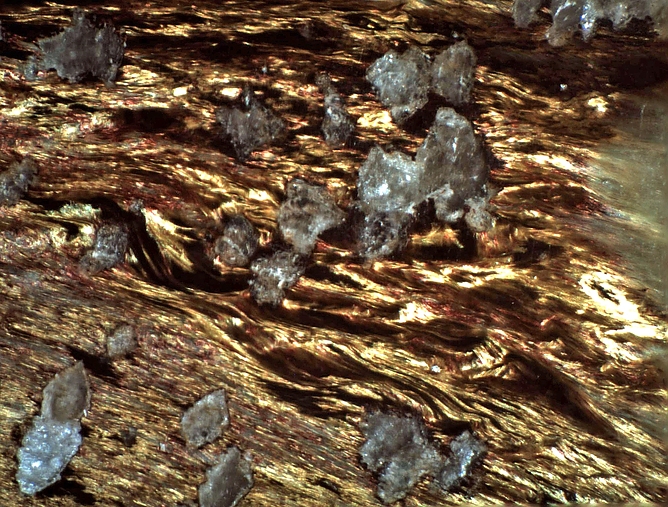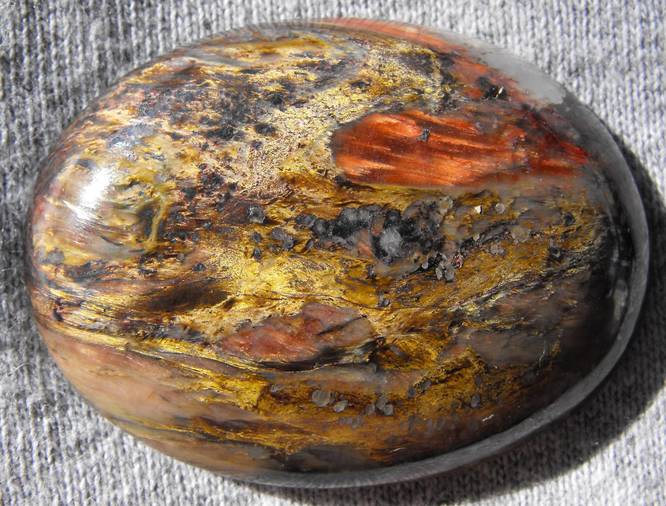Binghamite
A variety of Quartz
This page is currently not sponsored. Click here to sponsor this page.
About Binghamite
Formula:
SiO2
Colour:
Yellowish to reddish
Name:
Bill Bingham, Minnesota Mineral Club co-founder and first president, first described the material now called "binghamite" in 1936.
A variety of Chalcedony
Binghamite refers to a diverse group of lapidary materials from the mines on the Cuyuna North Iron Range in Crow Wing County, Minnesota. It is related to Minnesota silkstone and Minnesota tigers' eye. In fact all three materials can be found in the same specimen and grade into each other. These consist of colorful, variably chatoyant, silicified materials formed in fault zones cutting the banded iron ore of the Proterozoic Trommald Formation. The chaotic brecciation, with interleaved zones of red, yellow, brown, white and rarely blue material, make this an attractive material for slabs and cabochons. Although often referred to as "agate" or "chalcedony", only a few late-stage fillings are true agate. It is probably better related to jasper.
Binghamite and its related rocks consist of fibrous materials - primarily amphiboles - intergrown with fine to coarse-grained crystalline quartz. The amphiboles are insipiently to completely altered to a complex mix of quartz, siderite, and various iron and manganese oxides, most notably hematite and goethite. Stilpnomelane, epidote and minnesotaite have also been found in thin section study. The mineralogy of the rock has so far (2023) been only cursorily examined. Study of some of the amphiboles show them to be very complex, with chemistry best matching ferro-riebeckite and ferro-glaucophane. Amphiboles of the grunerite - cummingtonite series in the magnesium-iron-manganese subgroup are also present. These are often as fibrous asbestos ("crocidolite"), so proper safety measures are strongly recommended during the lapidary working on this material.
Bill Bingham, Minnesota Mineral Club co-founder and first president, first described the material now called "binghamite" in 1936. The term "silkstone" was introduced in 1956 by rockhound Ray Lulling of St. Paul (Kammerer, 1989). The differences between binghamite, Minnesota tigers' eye and silkstone are difficult to explain. A large specimen may contain, to the discerning eye, all three materials. All are quartz-rich. With few exceptions the quartz is not chalcedony but instead a fine-grained but macrocrystalline quartz. All are brightly colored, with the colors mainly due to included hematite, goethite and, occasionally, manganese minerals. The blue is unaltered riebeckite or glaucophane. All show some degree of chatoyancy, with Minnesota tiger's eye being most chatoyant.
A description of these materials from lapidarists point out a few subjective differences. That being said some Minnesota lapidarists have expressed the opinion that there is no meaningful distinction between Minnesota silkstone, tigers' eye and binghamite. Vender Harold Maine (unpublished document) notes that binghamite and silkstone have "no cleavage" - i.e. preferred direction of breakage when worked - while tiger's eye does. Silkstone is said to have fibers that are "seldom straight and parallel to each other They are usually in masses that have been bent, twisted and crumbled before being silicified" (Kammerer, 1989). Binghamite can sport long colorful irregular fibers but can also be more massive. The fibrous character of silkstone and tigers'eye is more pronounced. Irregular masses of snow white quartz occur in some silkstone. Some binghamite samples have rare areas of agate which also show an iris effect when slabbed, polished and back lit. These are late-stage, post-deformation deposits.
Binghamite is only briefly mentioned in the technical literature by geologists visiting the Cuyuna mines when they were operating (Schmidt, 1963). Schmidt described binghamite in the "veins and fracture fillings" section. He states that binghamites are "sheared" with the chatoyancy due to hematite and goethite likely pseudomorphic after other minerals. Schmidt describes a number of veins cutting the iron formation, primarily along major joints. These generally contain minerals similar to that in the adjacent wall rock. Many of these veins appear to be synchronous with the metamorphism. Documented minerals in the syn-metamorphic veins include quartz, stilpnomelane, siderite, acmite, nontronite and grunerite These often alter to quartz-hematite-goethite mixtures. Minnesota lapidarist Ray Lulling described silkstone as occurring in "vertical cracks and separations" cutting the host rocks (Kammerer, 1989). Hand specimen and thin section studies emphasize the shearing, crumpling and brecciation that is ubiquitous in these materials. The crack-seal model for African tiger's eye formation proposed by Heaney and Fisher (2003) model appears well suited to explain the binghamite, silkstone and tigers' eye of the Cuyuna Range.
 Visit gemdat.org for gemological information about Binghamite.
Visit gemdat.org for gemological information about Binghamite.
Binghamite refers to a diverse group of lapidary materials from the mines on the Cuyuna North Iron Range in Crow Wing County, Minnesota. It is related to Minnesota silkstone and Minnesota tigers' eye. In fact all three materials can be found in the same specimen and grade into each other. These consist of colorful, variably chatoyant, silicified materials formed in fault zones cutting the banded iron ore of the Proterozoic Trommald Formation. The chaotic brecciation, with interleaved zones of red, yellow, brown, white and rarely blue material, make this an attractive material for slabs and cabochons. Although often referred to as "agate" or "chalcedony", only a few late-stage fillings are true agate. It is probably better related to jasper.
Binghamite and its related rocks consist of fibrous materials - primarily amphiboles - intergrown with fine to coarse-grained crystalline quartz. The amphiboles are insipiently to completely altered to a complex mix of quartz, siderite, and various iron and manganese oxides, most notably hematite and goethite. Stilpnomelane, epidote and minnesotaite have also been found in thin section study. The mineralogy of the rock has so far (2023) been only cursorily examined. Study of some of the amphiboles show them to be very complex, with chemistry best matching ferro-riebeckite and ferro-glaucophane. Amphiboles of the grunerite - cummingtonite series in the magnesium-iron-manganese subgroup are also present. These are often as fibrous asbestos ("crocidolite"), so proper safety measures are strongly recommended during the lapidary working on this material.
Bill Bingham, Minnesota Mineral Club co-founder and first president, first described the material now called "binghamite" in 1936. The term "silkstone" was introduced in 1956 by rockhound Ray Lulling of St. Paul (Kammerer, 1989). The differences between binghamite, Minnesota tigers' eye and silkstone are difficult to explain. A large specimen may contain, to the discerning eye, all three materials. All are quartz-rich. With few exceptions the quartz is not chalcedony but instead a fine-grained but macrocrystalline quartz. All are brightly colored, with the colors mainly due to included hematite, goethite and, occasionally, manganese minerals. The blue is unaltered riebeckite or glaucophane. All show some degree of chatoyancy, with Minnesota tiger's eye being most chatoyant.
A description of these materials from lapidarists point out a few subjective differences. That being said some Minnesota lapidarists have expressed the opinion that there is no meaningful distinction between Minnesota silkstone, tigers' eye and binghamite. Vender Harold Maine (unpublished document) notes that binghamite and silkstone have "no cleavage" - i.e. preferred direction of breakage when worked - while tiger's eye does. Silkstone is said to have fibers that are "seldom straight and parallel to each other They are usually in masses that have been bent, twisted and crumbled before being silicified" (Kammerer, 1989). Binghamite can sport long colorful irregular fibers but can also be more massive. The fibrous character of silkstone and tigers'eye is more pronounced. Irregular masses of snow white quartz occur in some silkstone. Some binghamite samples have rare areas of agate which also show an iris effect when slabbed, polished and back lit. These are late-stage, post-deformation deposits.
Binghamite is only briefly mentioned in the technical literature by geologists visiting the Cuyuna mines when they were operating (Schmidt, 1963). Schmidt described binghamite in the "veins and fracture fillings" section. He states that binghamites are "sheared" with the chatoyancy due to hematite and goethite likely pseudomorphic after other minerals. Schmidt describes a number of veins cutting the iron formation, primarily along major joints. These generally contain minerals similar to that in the adjacent wall rock. Many of these veins appear to be synchronous with the metamorphism. Documented minerals in the syn-metamorphic veins include quartz, stilpnomelane, siderite, acmite, nontronite and grunerite These often alter to quartz-hematite-goethite mixtures. Minnesota lapidarist Ray Lulling described silkstone as occurring in "vertical cracks and separations" cutting the host rocks (Kammerer, 1989). Hand specimen and thin section studies emphasize the shearing, crumpling and brecciation that is ubiquitous in these materials. The crack-seal model for African tiger's eye formation proposed by Heaney and Fisher (2003) model appears well suited to explain the binghamite, silkstone and tigers' eye of the Cuyuna Range.
 Visit gemdat.org for gemological information about Binghamite.
Visit gemdat.org for gemological information about Binghamite.Unique Identifiers
Mindat ID:
7622 (as Binghamite)
3337 (as Quartz)
3337 (as Quartz)
Long-form identifier:
mindat:1:1:7622:3 (as Binghamite)
mindat:1:1:3337:0 (as Quartz)
mindat:1:1:3337:0 (as Quartz)
GUID
(UUID V4):
(UUID V4):
82c38059-b926-4d84-908c-99a5485327c7 (as Binghamite)
4ca61d6f-75f8-4208-8fb2-3b0eecbcd8f0 (as Quartz)
4ca61d6f-75f8-4208-8fb2-3b0eecbcd8f0 (as Quartz)
Physical Properties of Binghamite
Colour:
Yellowish to reddish
Chemistry of Binghamite
Mindat Formula:
SiO2
Elements listed:
Synonyms of Binghamite
Other Language Names for Binghamite
German:Binghamit
Spanish:Binghamita
Common Associates
Associated Minerals Based on Photo Data:
| 2 photos of Binghamite associated with Quartz | SiO2 |
| 1 photo of Binghamite associated with Magnesio-riebeckite | ◻{Na2}{Mg3Fe3+2}(Si8O22)(OH)2 |
| 1 photo of Binghamite associated with Amphibole Supergroup | AB2C5((Si,Al,Ti)8O22)(OH,F,Cl,O)2 |
| 1 photo of Binghamite associated with Goethite | α-Fe3+O(OH) |
Other Information
Health Risks:
This material contains asbestiform amphiboles and should not be worked without adequate protection.
Internet Links for Binghamite
mindat.org URL:
https://www.mindat.org/min-7622.html
Please feel free to link to this page.
Please feel free to link to this page.
Search Engines:
Mineral Dealers:
References for Binghamite
Reference List:
Localities for Binghamite
Locality List
 - This locality has map coordinates listed.
- This locality has map coordinates listed.
 - This locality has estimated coordinates.
ⓘ - Click for references and further information on this occurrence.
? - Indicates mineral may be doubtful at this locality.
- This locality has estimated coordinates.
ⓘ - Click for references and further information on this occurrence.
? - Indicates mineral may be doubtful at this locality.
 - Good crystals or important locality for species.
- Good crystals or important locality for species.
 - World class for species or very significant.
(TL) - Type Locality for a valid mineral species.
(FRL) - First Recorded Locality for everything else (eg varieties).
- World class for species or very significant.
(TL) - Type Locality for a valid mineral species.
(FRL) - First Recorded Locality for everything else (eg varieties).
All localities listed without proper references should be considered as questionable.
USA | |
| [www.wmnh.com] |







 symbol to view information about a locality.
The
symbol to view information about a locality.
The 



Cuyuna North Range, Crow Wing County, Minnesota, USA